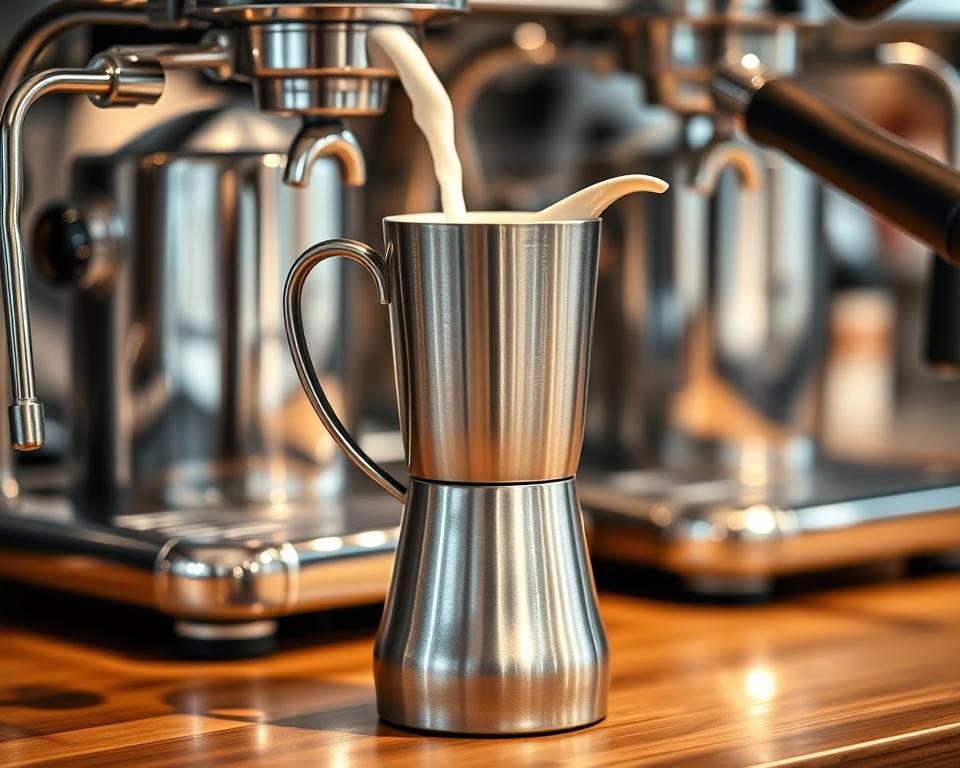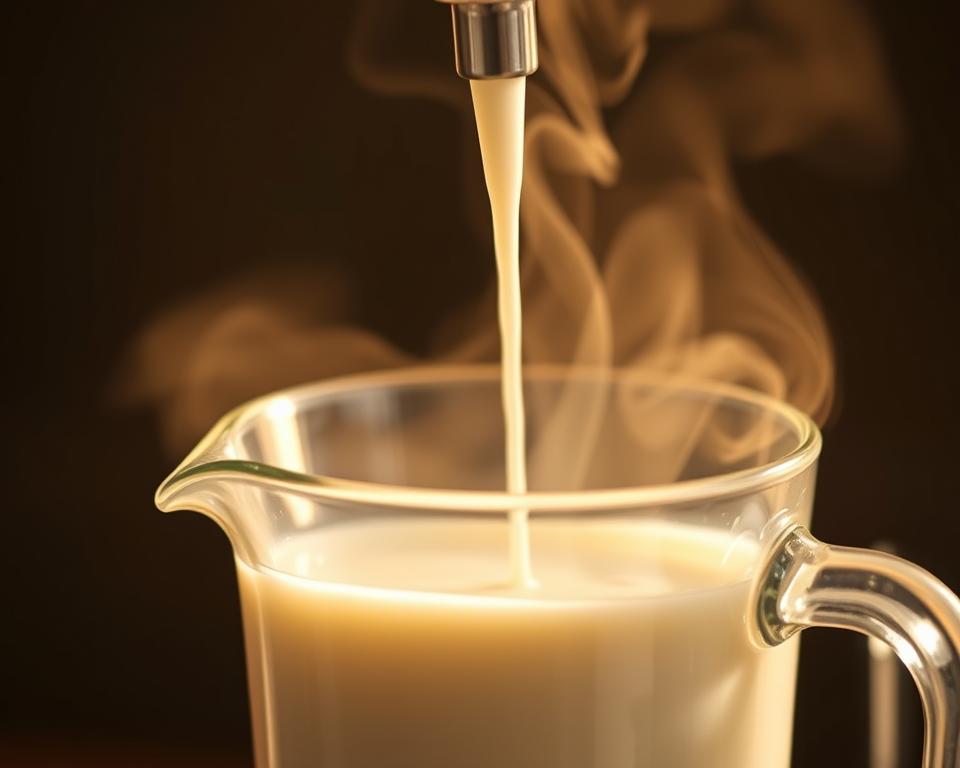Mastering milk steaming temperatures is key to crafting the perfect latte. It demands a grasp of milk steaming temperature control. The type of milk, steam wand position, and temperature all play crucial roles. For instance, the ideal steaming range is between 140°F and 145°F. Utilizing a contactless digital coffee milk thermometer, like the one at milk temperature control, ensures you hit the mark.
For any barista, learning to steam milk for lattes is vital. It involves grasping milk composition and ideal steaming temperatures. Milk’s proteins and fats significantly influence steaming results. Employing the correct techniques can yield perfect microfoam. With dedication and practice, you can excel in milk steaming, enhancing your coffee creations.
Introduction to Milk Steaming
Optimal milk steaming temperature is essential for crafting top-notch coffee drinks. It necessitates a thorough understanding of the milk steaming process. By honing your milk steaming temperature control and learning to steam milk for lattes, you can elevate your coffee-making skills.
Key Takeaways
- Mastering milk steaming temperatures is crucial for creating a perfect latte.
- The ideal temperature range for steaming milk is between 140°F and 145°F.
- Using a contactless digital coffee milk thermometer can help you achieve the perfect temperature.
- Learning how to steam milk for latte is an essential skill for any barista.
- Optimal milk steaming temperature is critical for creating high-quality coffee beverages.
- Mastering milk steaming temperature control can help you create perfect microfoam and improve your skills as a barista.
Understanding Milk Composition and Steaming
Steaming milk effectively requires a deep understanding of its composition. The ideal milk frothing temperature guide points to whole milk as the top choice. This is because it offers a perfect balance of fat and protein. Yet, other milks like oat milk from Califia Farms can also yield great results. The goal is to find the best temperature for steaming milk that enhances its natural sweetness and creaminess.
A milk frothing temperature guide is vital for achieving the ideal microfoam. It’s important to note that colder milk gives you more time to work with the foam. The steam wand should be placed halfway between the pitcher’s center and its outer wall for proper aeration. Submerging the steam wand too deeply can lead to large bubbles and a messy outcome.
Some key milk frothing tips include using a steaming pitcher that’s larger than the milk volume. Also, adjust the tilt for a smooth spin. The ideal steaming temperature is when the pitcher’s side feels too hot to touch for over a second. By adhering to these guidelines and using the right tools, you can achieve a glossy, pearlescent milk surface with small, almost invisible bubbles.
Ideal Milk Steaming Temperatures
Achieving perfect milk foam is key to making tasty coffee drinks. Milk steaming techniques are crucial in this process. The ideal milk temperature for coffee is about 150°F (65°C), fitting within the milk frothing range.
To get the perfect microfoam, knowing the optimal milk temperature is essential. The ideal steaming range is between 155 to 165 degrees Fahrenheit.
The recommended initial steaming temperature is around 150 degrees Fahrenheit. It’s also crucial to note that the steamer wand should stay just below the milk’s surface for about 5 seconds.
Here are some recommended temperatures for different drinks:
- Cappuccinos: 140°F – 150°F (60°C – 65°C)
- Lattes: 150°F – 160°F (65°C – 70°C)
- Flat whites: 140°F – 150°F (60°C – 65°C)
- Macchiatos: around 140°F (60°C)
By mastering milk steaming techniques and understanding the milk frothing temperature range, baristas can create perfect milk foam and delicious coffee beverages.
Achieving the Perfect Microfoam
To craft a flawless latte, mastering the art of microfoam is paramount. Microfoam is a critical element, and its quality can significantly impact the latte’s overall taste. Optimal milk steaming temperature control is essential for achieving this. The ideal steaming range is between 140°F and 160°F, ensuring a smooth, creamy texture.
Steaming milk for a latte requires precision and the right tools. A steam wand is indispensable, and it must be purged to remove condensation. Insert the steam wand at an angle into the milk. Steam it to the correct temperature and texture. The milk steaming temperature control is crucial for perfect microfoam.
Here are some tips for creating microfoam:
- Use whole cow’s milk with approximately 3% milk fat for optimal steaming results.
- Maintain a proper tilt of the jug during steaming to enhance the milk spin and texture.
- Clean the steam wand regularly to prevent milk from hardening around the steam tip holes.
By adhering to these guidelines and honing your technique, you can achieve the ideal microfoam. This will result in a delectable latte. Remember, optimal milk steaming temperature and milk steaming temperature control are key to a smooth, creamy texture. How to steam milk for latte is an art that demands practice and patience.
Equipment for Steam Control
Mastering the perfect milk frothing temperature requires the right equipment. A guide on milk frothing temperature is essential, but the tools matter too. We’ll look at steam control equipment, like steam wands and milk steaming machines, to help you achieve consistent results.
The steam wand is crucial in the frothing process. Its position and depth significantly influence the milk’s quality. By placing the steam wand correctly, you can create a whirlpool. This helps incorporate air, resulting in smooth, silky froth.

The type of milk steaming machine also affects your froth’s quality. Automatic machines offer consistency and ease but lack control compared to manual ones. Choose based on your needs and preferences to ensure perfect froth every time.
Common Mistakes in Milk Steaming
Milk steaming is an art that demands precision and technique. Even seasoned baristas can fall into common pitfalls that impact milk foam quality. Understanding these mistakes and how to sidestep them is crucial. The key is to maintain the milk frothing temperature between 150°F to 155°F (65°C to 68°C) for the best results.
Overheating the milk is a common error, leading to a burnt taste and denatured proteins. Inadequate foam quality often stems from poor technique. It’s also vital to keep the steam wand clean to prevent milk residue from contaminating it.
To sidestep these errors, grasping the ideal milk steaming temperature range is essential. Achieving perfect milk foam takes practice and patience. With the right techniques and equipment, anyone can excel in milk steaming. By adhering to the correct temperature and techniques, you can craft beautiful, creamy foam that elevates your coffee’s flavor and texture.
Tips for Experimenting with Temperature
Mastering milk steaming temperature control is key to perfecting flavor and texture. It’s vital to experiment with various milk types and temperature settings. Barista Hustle suggests aiming for a temperature between 130-135°F (54-57°C) for the best results. Achieving this requires patience and practice, essential for steaming milk to perfection.
Exploring different temperatures can help you find your ideal balance. The optimal milk steaming temperature varies based on milk type and desired flavor. Some prefer a higher temperature, like 145°F (63°C), while others opt for 130-135°F. The fat content of the milk also plays a role, with higher fat milks needing more aeration.
Here are some tips for experimenting with temperature:
- Begin with a lower temperature and gradually increase it to find the optimal temperature for your milk.
- Utilize a thermometer to monitor the temperature and make necessary adjustments.
- Try different milk types, such as whole, skim, or non-dairy alternatives, to discover your preference.

By following these guidelines and honing your milk steaming skills, you can enhance the flavor and texture of your lattes and other milk-based beverages. Always use fresh, high-quality milk and maintain your equipment well to achieve the best outcomes.
Understanding Dairy Alternatives
Mastering the art of frothing dairy alternatives is key. A milk frothing temperature guide is essential for finding the ideal steaming temperature. This is true whether you’re working with almond milk, oat milk, or soy milk. The sweet spot for dairy milks is between 131°F (55°C) and 149°F (65°C). Yet, non-dairy milks are more sensitive to heat.
Oat milk, known for its creamy texture, can mimic whole milk’s silky microfoam. Yet, achieving this requires precise milk frothing tips. The steaming temperature for these milks should be around 55-60 degrees Celsius.
Steaming dairy alternatives requires careful consideration:
- Almond milk can produce a thinner microfoam and may result in a bitter aftertaste.
- Soy milk is noted as the most prevalent alternative milk that experiences issues when combined with coffee.
- Coconut milk is noted for having a heavier mouthfeel and creating a sweeter, glossy foam.
By adhering to these guidelines and using the best temperature for steaming milk, you can craft dairy alternative drinks that match their dairy-based counterparts. Experiment with various milks and adjust your frothing technique to achieve the ideal microfoam.
Secrets from Professional Baristas
Professional baristas have perfected the art of milk steaming, sharing secrets to achieve perfect milk foam. By learning from coffee competitions and training programs, you can enhance your skills. For instance, milk steaming techniques are key to crafting the perfect coffee.
Controlling the milk frothing temperature is crucial. The ideal range is between 140 and 149 degrees Fahrenheit. Whole milk, with its higher fat content, is preferred for its creamy texture. Proper technique involves creating a whirlpool effect, which adds air gradually, resulting in a smooth texture.
Some tips for optimizing your barista skills include:
- Practice regularly to develop muscle memory and improve your technique
- Use high-quality milk and equipment to ensure the best results
- Experiment with different milk types and flavors to find your favorite
Continuous learning and development are vital for any barista. Staying current with trends and techniques helps refine your skills. Whether you’re an experienced barista or just starting, mastering milk steaming techniques is achievable. With dedication and practice, you can become a skilled barista, creating delicious coffee drinks that impress.
The Science Behind Milk Steaming
Milk steaming is a complex process that delves into the physics of steam and heat, alongside the chemistry of milk. Achieving optimal milk steaming temperature control requires understanding milk’s composition. This includes its water, fat, and protein content. Cow’s milk is mostly water, with fats and proteins making up a smaller percentage.
For those looking to steam milk for a latte, the ideal temperature is key. The optimal range for milk steaming is between 140°F and 160°F, varying by milk type. Soy and almond milks, for instance, need lower temperatures, around 150°F and 140°F, respectively. Grasping the science behind milk steaming is crucial for creating the perfect microfoam and flavor.
The chemistry of milk during steaming significantly impacts its final texture and taste. The Maillard reaction, which happens when milk is heated above 100°C, can alter its nutritional value and flavor. By managing the milk steaming temperature, baristas can control the Maillard reaction. This helps in producing high-quality steamed milk.
Customer Preferences and Trends
In the coffee industry, grasping consumer preferences is key. It shapes the demand for certain products and services. Datassential’s Consumer Preferences show that 76% of consumers enjoy coffee, creating a large market for coffee-related items. The milk frothing temperature guide is crucial in meeting these expectations, as the right temperature can significantly improve the coffee experience.
A survey with 2,013 US consumers found interesting trends. Gen Z and younger Millennials prefer non-dairy milk or creamers, with 47% and 55% respectively. This contrasts with 35% of Gen X and 25% of Baby Boomers. This shift underscores the need to adapt to changing tastes by offering various milk options. By following the best temperature for steaming milk, baristas can ensure each cup meets customer expectations.
- Personalization: 48% of Gen Z believe that personalization in coffee orders is an expectation rather than a luxury.
- Flavored coffee: 73% of Gen Z express a strong preference for flavored coffee beverages.
- Sustainability: Consumers are increasingly looking for eco-friendly and sustainable options, which can be achieved by implementing efficient milk frothing tips and reducing waste.
By keeping abreast of the latest trends and consumer preferences, coffee shops can refine their offerings. This ensures they meet the evolving demands of their customers. Such adjustments can significantly enhance the customer experience and drive business growth.
Final Thoughts on Milk Steaming Mastery
Mastering milk steaming is a blend of technique, knowledge, and experimentation. Understanding the ideal temperatures is key to creating perfect microfoam. This enhances the flavor and texture of your coffee. The optimal range is between 55°C to 65°C. Temperatures above 65°C can cause irreversible chemical changes, affecting taste.
Keep practicing and experimenting with various milk types, including dairy alternatives like almond, oat, and soy milk. Each type requires subtle adjustments to achieve the desired results. Stay curious and open to trial and error. Don’t hesitate to seek out additional resources for aspiring baristas. Whether it’s attending a latte art workshop or reading up on the latest trends, there’s always more to learn.
The journey to milk steaming mastery is ongoing. With the right techniques and dedication to improvement, you can elevate your coffee creations. Delight your customers with consistently exceptional beverages. Embrace the process, have fun, and enjoy the rewards of your hard work as you continue to hone your craft.
FAQ
What is the importance of understanding milk composition for achieving perfect steaming temperatures?
What is the optimal temperature range for steaming milk?
What is microfoam, and how can it be achieved through milk steaming techniques?
How do different types of steam wands and milk steaming machines impact the quality of steamed milk?
What are some common mistakes in milk steaming that can lead to poor foam quality and overheating?
How can experimenting with temperature and milk types help achieve the perfect steaming results?
What are some tips from professional baristas for mastering milk steaming techniques?
How does the science behind milk steaming impact the overall quality and taste of the final product?
How do customer preferences and trends influence the importance of mastering milk steaming temperatures?

Paul Allen is a writer at WyNeeds, a website dedicated to the world of coffee. Passionate about aromas and flavors, he explores everything from the best brewing methods to fascinating insights about coffee beans and industry trends. His goal is to provide readers with engaging and informative content, helping both beginners and coffee enthusiasts deepen their knowledge of the world’s most beloved beverage.

